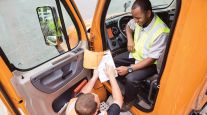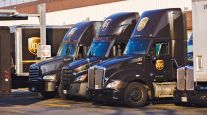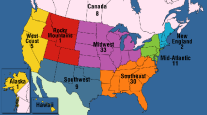Reimagining Trucking

The nation’s largest for-hire carriers are embracing new technologies and doing more to foster innovation with the goal of reducing the cost of moving freight and providing new service capabilities.
The result will be an industry that is much more automated, less defined by assets and, perhaps, a more rewarding place to work, according to company executives and freight industry observers.
2018 TT TOP 100 FOR-HIRE RANKINGS: See the new list
COMING JULY 18: LiveOnWeb's 'Reimagining Trucking'
To get a sense of what this all looks like, consider what’s happening at J.B. Hunt Transport Services in Lowell, Ark.
The iconic company shifted away from its over-the-road truckload business in the 1990s to become the nation’s largest intermodal carrier and then built up substantial new businesses in freight brokerage and dedicated contract carriage.
Now it is turning itself into a logistics engineering enterprise that relies on advanced data analytics to manage freight movement regardless of mode to and from anywhere in North America.
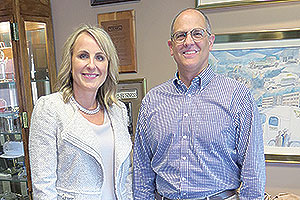
J.B. Hunt's Shelley Simpson (left) and Stuart Scott by Daniel P. Bearth/Transport Topics
Leading the transformation is Shelley Simpson, the company’s chief commercial officer, and Stuart Scott, a former Microsoft executive who serves as executive vice president and chief information officer and heads up a staff of 100 logistics engineers and data scientists that soon will be housed in an office building under construction at J.B. Hunt’s corporate headquarters.
“Data is critical,” Simpson said in describing her vision in a recent exclusive interview with Transport Topics. “We want to be a place where we can look at all shipment data and all available capacity to create the most efficient transportation networks in North America or in the world.”
J.B. Hunt has committed $500 million over five years to change the way the company thinks about data and how it can be used. One change is to move data from mainframe computers to cloud-based networks. Another is reflected in a program called J.B. Hunt 360, which provides mobile applications to help drivers secure loads and give shippers access to information about the status of their shipments.
For trucking companies such as J.B. Hunt that handle large volumes of shipments, technology can be used to accelerate the pace of change because there’s so much information available to work with. “If you have data, you can create value,” Scott said.
At Pitt Ohio, a less-than-truckload carrier based in Pittsburgh, a discussion about safety led to the development of software that crunched data in a way that made it possible to accurately predict when drivers were at high risk of crashes or leaving their job.
The program, called SafetyBox, led to the creation of a company called Idelic that was spun off and now is selling its services to other companies.
“We decided early on that service and technology would be a competitive advantage,” said Charles Hammel IV, senior vice president of supply chain services at Pitt Ohio and an executive with the Pitt Ohio Transportation Group that provides truckload and LTL service, package delivery and related logistics services.
Pitt Ohio was among the first to adopt centralized billing and dispatch functions and to use imaging technology to speed up the flow of information from its network of freight terminals. And it was the first LTL carrier to install in-cab computers, which dramatically improved communications with drivers and captured key information about detention and claims.
Hammel said the idea for SafetyBox came out of a need for a central repository for information about drivers and better ways to assess performance, streamline compliance tasks and improve the management of risk.
The safety department at Pitt Ohio worked with students and alumni at Carnegie Mellon University to analyze 20 years of data on 12,000 drivers in an effort to develop software that could identify drivers at the highest risk of crashes or leaving the company.

Cardiff
Based on that work, the company’s artificial intelligence program was able to predict with 90% accuracy which drivers will get into accidents, Idelic CEO Hayden Cardiff said. Drivers receive a risk score from 1 to 100 based on a list of weighted variables, including the number of driving violations and incidents on the job, plus data on training, medical conditions such as sleep apnea and even reports of horseplay on the dock or changes in mood that may reflect personal problems, Cardiff said.
The system can be adapted to predict violations, incidents, injuries and other risk metrics for not only fleet operators, but warehousing and shipping firms and insurance underwriters.
For companies that have adopted Idelic’s technology, the results have been dramatic, said Hammel, who cited a 52% drop in accidents, a decline from 30% to 16% in the rate of annual driver turnover, lower insurance premiums and even a marketing boost as shippers funnel more freight to carriers with better safety records.
For Idelic, an even bigger payoff is possible if the company can find a way to calculate risk for the entire pool of commercial truck drivers.
“There’s no Carfax for drivers,” Cardiff said. “But an Idelic risk score can go with drivers and with a central database it would be like getting a credit score.”
At Liquid Trucking Cos. in Plattsmouth, Neb., Jason Eisenman came up with the idea of using the driver’s mobile phone to record details about locations where they are picking up or delivering bulk agricultural, food grade and hazmat product in tank trailers.
That kind of “delivery reconnaissance” proved to be an invaluable tool for drivers and for the home office. In 2016, Eisenman, director of human resources at Liquid Trucking, formed Epic Ideas to develop a commercial enterprise version of the company’s mobile app called DeliveRecon.
“The interactive mobile app has electrified the work experience for our drivers and accelerated on-the-job training,” Eisenman explained. “Our new drivers are able to hit the ground running. The app also gives us higher levels of customer service, safety, efficiency and cash flow.”
As these three examples illustrate, companies are getting employees at all levels involved in the process of innovation.
At J.B. Hunt, for instance, more than 100 employees have had their names placed on a “wall of fame” at corporate headquarters for ideas that were reviewed, implemented and judged to be successful. The company also maintains a close relationship with the University of Arkansas in Fayetteville, where executives often serve as guest lecturers and students are given real-world logistics problems to solve.

Rogers
The driving force for innovation is the demand from shippers for more and better services, said Ryan Rogers, a former Amazon.com executive who last year was named chief transformation officer at Covenant Transport in Chattanooga, Tenn.
“We’re looking at a different way to do business because customers have higher expectations,” Rogers said.
Some new ideas will come from outside the industry and from startup companies offering technology that may be unfamiliar to trucking firms.
“Technology has to be proven,” Rogers noted. “It has to be something that moves the bottom line.”
One startup that is working with Covenant is WorkHound, a company that has developed a system for gathering anonymous feedback from drivers to help management address issues that affect driver satisfaction and lead to excessive turnover.

Max Farrell, co-founder of WorkHound (Daniel P. Bearth/Transport Topics)
“We give drivers a voice,” said Max Farrell, a co-founder of WorkHound who moved to Chattanooga from Des Moines, Iowa, in part, to take advantage of opportunities for contact with major trucking employers. WorkHound is working with about 20 other companies and has about 10,000 drivers using its services.
For trucking executives, the technologies that are considered the most significant to their business now are those that have a positive effect on safety, visibility and decision-making, according to a survey conducted by Transport Topics for the Top 100 For-Hire Carriers list this year.
Executives at refrigerated hauler Marten Transport in Mondovi, Wis., cited “real-time” tracking and safety technologies, including collision avoidance and lane departure warning systems, as the most significant to its business.
“We’re focused on supply chain visibility,” said Lara Falcone, a marketing project manager at Estes Express Lines in Richmond, Va. “The key for us has been growing the flexibility of our systems where we can offer the right information at the right time for customers.”
Envisioning the Future of Trucking
Readers describe their vision of the future of freight transportation.
3D printing will be the next big technology phase to affect transportation and logistics. It should reduce the amount of trucks on the road as consumers will be able print “goods” instead of going to a store to purchase.
— John Millican, branch sales manager, Interstate NationaLease
It’s no secret the self-driving trucks are the hot item right now when people look to the future, but what about trucks that can do more than just get from point A to point B? What if products were created within the truck as the truck is driving along its route? Consider it manufacturing from within. Of course this may not be an option for larger items, but think of the reduction in lead time if products can be produced while being transported.
— Olivia Young, director of marketing at Navajo Express Inc.
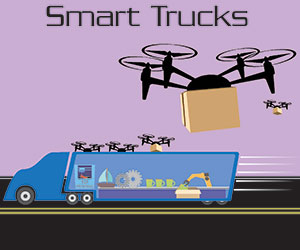
We will see freight transformed in ways that make the Jetsons come to life. The demand for freight is going to continue to grow, and how it is moved will be driven by technology. However, the acceleration of change will occur in phases as key inflection points are realized.
Initially, adoption of blockchain technology will have a massive impact in the transportation industry.
The deployment of sensors, the core of the Internet of Things, will explode as predicted.
We will have certain lanes for drivers and different lanes for platooning and autonomous trucking.
Finally, the demand for infrastructure improvements will spike, and we will evolve into smart cities. Technological advances are necessary to address last-mile deliveries and accommodate driverless vehicles, unmanned aerial vehicles (drones) and likely underground freight delivery channels. Artificial intelligence and machine learning will also play a big part in the automated delivery of packages to homes and businesses.
After these major milestones are achieved, we will likely see freight being delivered in ways that we can’t even imagine today.
— Craig Marris, executive vice president of mixed fleets at telematics firm Coretex
I think there are plenty of low-hanging fruit when it comes to automation, from platooning of trucks across long stretches of interstate highways to improved real-time load tracking. Predictive analytics will increase in use, especially in diversion and rescheduling of loads to avoid congestion/bottlenecks.
The suburban landscape will be transformed from big- and medium-box retail to quick pick-up fulfillment stops, with one every 1 or 2 miles to cover most residential areas within a five-minute drive. However, there will be “boutique” brick-and-mortar stores that retain a cachet with customer service and personal connections absent elsewhere. These will be geared towards younger customers who long for personal and community connections.
— Freight planning analyst for Wisconsin Department of Transportation
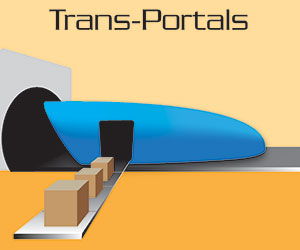
The Boring Co. is building underground tunnels for transport between large cities for pedestrians and public transit. I recommend making the tunnels freight-friendly and getting more trucks, containers and cargo off the highways!
— Joseph Enright
I think cargo is being transformed into a landscape of artificial intelligence-driven algorithms where robots like the ones currently used in Amazon fulfillment centers will coordinate shipments and highly automate the logistical/warehousing aspect with minimal human intervention.
— Victor Oaxaca, transportation insurance underwriter
I envision a future state where automated, LTL smart hubs will exist to allow shippers and carriers to manage and direct shipments while they are en route.
Today, shippers forecast their transportation needs, run optimization models to balance costs, transit times and production schedules. And then once they release shipments, have little or no ability to adjust on the fly.
The advent of smart hubs will allow shippers and motor carriers to adjust routing and the mode while shipments are in transit.
— Ben Wiesen, Carrier Logistics Inc.
The entire industry will be automated globally. Commodities will be automatically boxed and labeled on the line and funneled to the correct shipping consolidation box, which will be picked up by a drone and transported to the nearest transportation center.
Once injected into the global transportation center, the shipment will progress via air, ocean, rail, truck or drone all electronically, mechanically, robotically and redirected off the path at any point to deconsolidate, expedite or defer if able for better rates. The shipments will never be touched by human hands until they reach their final destination.
There will be robotically controlled warehouses as well as repair and return stations enabling these services to be conducted as close as possible geographically, eliminating much transportation and overhead expense.
Need a shipment of a product unexpectedly? You will be able to locate where in the global supply chain the product is available and make offers to the intended recipient to purchase the product out of the transportation system in order to receive sooner. These bids will be handled electronically with the highest bidder “winning” the product.
— Laura Hendrix, senior solutions specialist, FedEx Corp.
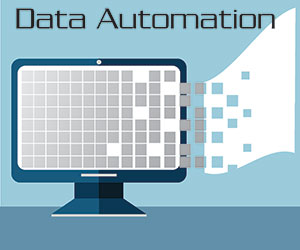
The first step in technology will be a refinement of the shattered brokerage business operating on multiple platforms. C.H. Robinson started the refinement of the platform years ago in the produce industry. The next big step will be a massive player — like an Amazon — that will step in and modernize the platform. Call it an all-knowing platform that links freight to power units. The artificial silos that are in place today will disappear. Bill Gates modernized the PC with Windows. That much of a quantum leap is needed in the platform.
The second step will be the refinement and creation of a workable marriage between the arriving truck and the shipper/receiver. The [7 a.m.-4 p.m.] working hour days will disappear as millennials take over and work strange hours. Those strange hours will provide for shipping and receiving at nontraditional hours. Freight will move in and out of cities at less congested times.
— Douglas Brockhouse, Sioux Falls, S.D.
The future of freight will incorporate blockchain technologies to create a more efficient, less cumbersome process within highly complex operating environments.
— Kamal Chetty
Based on the nature of the business, I’m not sure we’ll ever see the disappearance of the traditional 3PL. However, new tech and automated processes/vehicles will only help to better serve the intermediary and therefore the shippers and receivers. …For 3PLs, the mantra needs to be “new school tech, old school service.”
— Leif Olson, business development, TBrothers Logistics
Instead of expanding outwards or even upwards in the future, I believe that the future of transportation will go underground. Systems of large, vast tunnels will be the main conduit for goods to travel across the country in lightning fast speeds.
Each county in America will have a shipping and receiving staging warehouse, where each piece of freight will arrive before being loaded onto fully autonomous vehicles by robots for its final destination.
— Mike Thur, human resources and safety manager, Special Service Transportation, Brunswick, Ohio
James LaMarca, president of System Freight Inc., a New Jersey-based dedicated contract carrier, said onboard diagnostics technology, plus the ability to correct driver behavior and do predictive maintenance “is a key driver in our performance as a company.”
Autonomous vehicles, however, will one day become an “industry changing” technology, he added.
Nina Trifan, national marketing manager for Day & Ross Transportation Group in New Brunswick, Canada, listed business intelligence analytics and capturing shipping data as the most significant technology solutions for the business now, along with a strong digital and social media presence, predictive maintenance systems and telematics that connect drivers, freight and equipment.
At A. Duie Pyle Inc., CEO Peter Latta cited development of a mobile app in 2016 that allows drivers to take pictures of the bill of lading, scan the necessary bar codes and send information to the company’s billing department.
“This gives workers as much as six hours to begin the billing and planning process before drivers even arrive,” he said.
Looking ahead, artificial intelligence will play a bigger role in the trucking business, according to Latta.
“Routing for pickups, deliveries and linehaul will need to be more dynamic to provide the best service and cost solutions,” Latta explained. “Static parameters will be replaced by virtual solutions allowing optimal asset utilization [with] the best service and cost solution based on customer requirements for each shipment as opposed to one-size-fits-all service.”
At Hub Group, an intermodal, drayage and dedicated contract carrier, top executives said visibility and shipment tracking is a major focus of technology investment.
“We are leveraging the GPS capabilities of our container fleet, along with in-cab data from both our own fleet and third-party carriers to provide real-time data and enhanced predictive analytics,” said Brian Meents, senior vice president of enterprise customer solutions at Hub Group.
Automated driving technology also is likely to play a significant role in the future of trucking with multiple applications.
“Platooning will help improve safety and utilization by linking tractors together with an onboard system,” Meents said. “This has the lowest barrier to entry and strong implications for improved capacity efficiency.”
Another application for autonomous vehicle technology could include management of trailer pools through autonomous yard tractors.
“On a private lot, an autonomous yard goat can shuttle containers and trailers and operate longer than a driver,” Meents said.
While autonomous longhaul vehicles would have the biggest impact on the industry with improved safety, efficiency and reduced costs, Meents said the path to fully autonomous vehicles on public roads “is faced with broader regulatory challenges and adoption.”
In some cases, trucking firms are investing directly in technology companies as a way to spur innovation.
Green Bay, Wis.-based Schneider, for example, recently announced an investment in Platform Science to develop ways to leverage technology on trucks to supply data as part of a fully digital supply chain.
Investment in technology “differentiates us and enables optimized decisions that drive enhanced contribution [to profits],” Schneider Chief Information Officer Shaleen Devgun said. “Our in-cab telematics platform delivers customer location specific, step-by-step work assignments to our company driver fleet. Our trailer and container fleets are equipped with monitoring devices which function both when tethered to a tractor and standing alone.”
Schneider also has partnered with software firm Oracle Corp. to develop an internal technology platform called Quest that is used to support decisions about loads, pricing and equipment utilization.
“Decision support tools improve our ability to, among other things, situationally coach drivers, minimize fuel costs and maintain the fleet in the most cost-effective manner,” Devgun said. “The most significant application of such technology is in planning and dispatch.”
Schneider is working with existing vendors, including Omnitracs and SkyBitz Inc., to deploy the next generation of in-cab and trailer-tracking technologies.
The company also has agreed to purchase some battery-powered Tesla Semi trucks for testing.
“We have committed to purchase a limited amount of Tesla’s recently unveiled electric Semi trucks to improve the driver experience, decrease our carbon footprint and lower operating costs,” Devgun said.
“We are also leveraging mobile applications to better connect with company drivers and customers,” he added. “One example is a mobile application that prompts our company drivers to rate the shipping, receiving and driver support locations that they visit.”
At YRC Worldwide, CEO Darren Hawkins said his company has made significant investments in two technologies to help reduce costs associated with pickup-and-delivery operations.
One is a planning, scheduling and supply chain optimization program provided by Quintiq, a software firm based in the Netherlands. The other is HaulPlan, a linehaul planning and network optimization program provided by software firm Optym.
But the company also has taken steps to change the way it operates.
YRC Freight, the company’s national LTL business, added eight “quick sort” centers to its distribution network using drivers who bring in shipments to also sort the loads before returning to their origin terminal.
According to Hawkins, the new arrangement allows the carrier to handle 7,000 more shipments per day in about half the time that it would take going through the company’s current 23 distribution centers.
Technology also is helping YRC reduce the cost of handling more than 18 million invoices annually.
Using digital imaging and automated payment processes from a company called Billtrust, YRC was able to slash bank processing fees by $60,000 a month and speed up collections by half a day.
For some, innovation must extend beyond technology and rethink some basic aspects of how trucking operates.
One proponent of that approach is Brittain Ladd, an independent supply chain consultant who previously worked at Amazon.
Ladd’s idea is to create a consortium of trucking companies, large and small, that would use a common driver pool to haul freight between fixed points, not unlike the way the Pony Express once used horses and riders to carry mail across the country.
Drivers would have the authority to haul freight for any consortium member and would be paid an hourly rather than a per-mile rate. Trucks in the network could operate around the clock.
“If such a model were implemented,” Ladd said, “33% fewer trucks would be required to move the same number of loads that were hauled in 2017.”
Ladd said he has received positive feedback about the idea from trucking executives who see it as a way to create better working conditions for drivers while also providing more capacity at time when demand for freight hauling is strong.
“This is the best time to do this,” Ladd said.
During his time at Amazon, Ladd worked to design and implement strategies for the company to become a third-party logistics provider and expand into grocery retailing with Amazon Fresh and Pantry operations.
Other companies, including freight-matching technology firms Uber Freight and Convoy, have put forth proposals that also try to make life easier for drivers.
With its driver app and freight network, Uber Freight aims to connect drivers with loads that match their preferences and streamline the load-booking process.
Convoy recently established a trailer pool that allows independent owner-operators to pick up pre-loaded trailers.
“A major challenge facing the freight industry is a shortage of drivers and a limited number of trucks available to service shipments,” Austin Watkins, senior manager of growth at Convoy, said in a recent blog post. “An aging driver base paired with new regulations limiting hours of service have created one of the most challenging freight environments in decades.”
Watkins said Convoy expects to expand its trailer pool nationwide “in the near future.”


